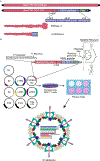Creation and characterization of a recombinant mammalian orthoreovirus expressing σ1 fusion proteins encoding human epidermal growth factor receptor 2 peptides
- PMID: 37634292
- PMCID: PMC10592078
- DOI: 10.1016/j.virol.2023.109871
Creation and characterization of a recombinant mammalian orthoreovirus expressing σ1 fusion proteins encoding human epidermal growth factor receptor 2 peptides
Abstract
Mammalian orthoreovirus (MRV) is an oncolytic virus that has been tested in over 30 clinical trials. Increased clinical success has been achieved when MRV is used in combination with other onco-immunotherapies. This has led the field to explore the creation of recombinant MRVs which incorporate immunotherapeutic sequences into the virus genome. This work focuses on creation and characterization of a recombinant MRV, S1/HER2nhd, which encodes a truncated σ1 protein fused in frame with three human epidermal growth factor receptor 2 (HER2) peptides (E75, AE36, and GP2) known to induce HER2 specific CD8+ and CD4+ T cells. We show S1/HER2nhd expresses the σ1 fusion protein containing HER2 peptides in infected cells and on the virion, and infects, replicates in, and reduces survival of HER2+ breast cancer cells. The oncolytic properties of MRV combined with HER2 peptide expression holds potential as a vaccine to prevent recurrences of HER2 expressing cancers.
Keywords: Breast cancer; Cancer vaccine; HER2; Mammalian orthoreovirus; Oncolytic virus.
Copyright © 2023. Published by Elsevier Inc.
Conflict of interest statement
Declaration of competing interest The authors declare that they have no known competing financial interests or personal relationships that could have appeared to influence the work reported in this paper.
Figures








References
-
- Adair RA, Roulstone V, Scott KJ, Morgan R, Nuovo GJ, Fuller M, Beirne D, West EJ, Jennings VA, Rose A, Kyula J, Fraser S, Dave R, Anthoney DA, Merrick A, Prestwich R, Aldouri A, Donnelly O, Pandha H, Coffey M, Selby P, Vile R, Toogood G, Harrington K, Melcher AA, 2012. Cell carriage, delivery, and selective replication of an oncolytic virus in tumor in patients. Sci Transl Med 4, 138ra177. - PMC - PubMed
-
- Andreasson K, Tegerstedt K, Eriksson M, Curcio C, Cavallo F, Forni G, Dalianis T, Ramqvist T, 2009. Murine pneumotropic virus chimeric Her2/neu virus-like particles as prophylactic and therapeutic vaccines against Her2/neu expressing tumors. Int J Cancer 124, 150–156. - PubMed
-
- Andtbacka RH, Kaufman HL, Collichio F, Amatruda T, Senzer N, Chesney J, Delman KA, Spitler LE, Puzanov I, Agarwala SS, Milhem M, Cranmer L, Curti B, Lewis K, Ross M, Guthrie T, Linette GP, Daniels GA, Harrington K, Middleton MR, Miller WH, Zager JS, Ye Y, Yao B, Li A, Doleman S, VanderWalde A, Gansert J, Coffin RS, 2015. Talimogene Laherparepvec Improves Durable Response Rate in Patients With Advanced Melanoma. J Clin Oncol 33, 2780–2788. - PubMed
-
- Andtbacka RHI, Collichio F, Harrington KJ, Middleton MR, Downey G, Ӧhrling K, Kaufman HL, 2019. Final analyses of OPTiM: a randomized phase III trial of talimogene laherparepvec versus granulocyte-macrophage colony-stimulating factor in unresectable stage III-IV melanoma. J Immunother Cancer 7, 145. - PMC - PubMed
-
- Barton ES, Connolly JL, Forrest JC, Chappell JD, Dermody TS, 2001a. Utilization of sialic acid as a coreceptor enhances reovirus attachment by multistep adhesion strengthening. J Biol Chem 276, 2200–2211. - PubMed
Publication types
MeSH terms
Substances
Grants and funding
LinkOut - more resources
Full Text Sources
Medical
Research Materials
Miscellaneous

